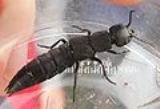
Staphyliniformia
Encyclopedia
Staphyliniformia is a large infraorder of beetle
s. It contains over 60,000 described species from all regions of the world. Most species occur in moist habitats - various kinds of rotting plant debris, fungi, dung, carrion, many live in fresh water.
suborder and is usually given an infraorder or series rank. It contains three superfamilies:
Some recent studies also include the superfamily Scarabaeoidea
(infraorder Scarabaeiformia), forming together the so called Hydrophiloid lineage. A sister group relationship of Hydrophiloidea and Histeroidea is strongly supported.
The unambiguous fossil record dates back to Triassic
, and an early Mesozoic
origin of the group is probable.
Beetle
Coleoptera is an order of insects commonly called beetles. The word "coleoptera" is from the Greek , koleos, "sheath"; and , pteron, "wing", thus "sheathed wing". Coleoptera contains more species than any other order, constituting almost 25% of all known life-forms...
s. It contains over 60,000 described species from all regions of the world. Most species occur in moist habitats - various kinds of rotting plant debris, fungi, dung, carrion, many live in fresh water.
Characteristics
Most Staphyliniforms are small to average sized beetles. The diverse group has few clear apomorphies. They have primitively 11-segmented antennae, a constricted neck well behind the eyes. The pronotum has a well defined, large lateral edge. Larval legs are 5-segmented, the 10th abdominal segment is often with more-or-less fine or strong spines or hooks. Urogomphi (paired "horns" at posterior tip of abdomen of larvae and pupae) with basal articulation.Systematics and Evolution
Staphyliniformia belongs to the PolyphagaPolyphaga
Polyphaga is the largest and most diverse suborder of beetles; the name is derived from two two Greek words: poly-, meaning 'many', and phagein, meaning 'to eat', so the suborder is called the “eaters of many things”...
suborder and is usually given an infraorder or series rank. It contains three superfamilies:
- HisteroideaHisteroideaHisteroidea is a superfamily of beetles in the infraorder Staphyliniformia.-Characteristics:Characteristic to Histeroidea are an accessory posterior ridge behind the hind margin and presence of medial loop and apical hinge of wing. Elytra truncate, 1 ot 2 abdominal segments visible, abdominal 8th...
, including the clown beetleClown beetleHisteridae is a family of beetles commonly known as Clown beetles or Hister beetles. This very diverse group of beetles contains 3,900 species found worldwide. They can be easily identified by their shortened elytra that leaves two of the seven tergites exposed, and their elbowed antennae with...
s. - HydrophiloideaHydrophiloideaHydrophiloidea is a superfamily of beetles. Until recently it only included a single family, the water scavenger beetles , but several of the subfamilies have been removed and raised to family rank.-External links:*...
, including the water scavenger beetleWater scavenger beetleHydrophilidae , also called water scavenger beetles, is a family of chiefly aquatic beetles. Aquatic hydrophilids are notable for their long maxillary palpi, which are longer than their antennae...
s - StaphylinoideaStaphylinoideaStaphylinoidea is a superfamily of beetles. It is a very large and diverse group with worldwide distribution.-Characteristics:Most staphylinoids are middle-sized or small beetles with a pair of shortened elytra. The hind wings have no accessory posterior ridge , no wedge cell and apical cell....
, including antlike stone beetles, carrion beetleCarrion beetleSilphidae is a family of beetles that are known commonly as carrion or burying beetles. There are two subfamilies: Silphinae and Nicrophorinae. Both families feed on decaying organic matter such as dead animals. The families differ in which uses parental care and which types of carcasses they prefer...
s, and rove beetleRove beetleThe rove beetles are a large family of beetles, primarily distinguished by their short elytra that leave more than half of their abdomens exposed. With over 46,000 species in thousands of genera, the group is the second largest family of beetles after the Curculionidae...
s.
Some recent studies also include the superfamily Scarabaeoidea
Scarabaeoidea
Scarabaeoidea is a superfamily of beetles, the only subgroup of the infraorder Scarabaeiformia. Around 35,000 species are placed in this superfamily and some 200 new species are described each year...
(infraorder Scarabaeiformia), forming together the so called Hydrophiloid lineage. A sister group relationship of Hydrophiloidea and Histeroidea is strongly supported.
The unambiguous fossil record dates back to Triassic
Triassic
The Triassic is a geologic period and system that extends from about 250 to 200 Mya . As the first period of the Mesozoic Era, the Triassic follows the Permian and is followed by the Jurassic. Both the start and end of the Triassic are marked by major extinction events...
, and an early Mesozoic
Mesozoic
The Mesozoic era is an interval of geological time from about 250 million years ago to about 65 million years ago. It is often referred to as the age of reptiles because reptiles, namely dinosaurs, were the dominant terrestrial and marine vertebrates of the time...
origin of the group is probable.

